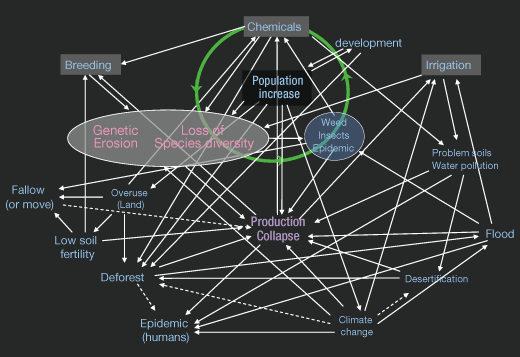Agriculture and Environment Interactions in Eurasia: Past, Present and Future -A ten-thousand-year history
Agriculture represents a fundamental change in relations between humanity and nature. This research project examined historical interplay of agriculture and environment, focusing on the relation between climate, crops and food consumption in three major agricultural zones of Eurasia: the Rice, Mugi, and Vegeculture Zones. Project research was designed to reconstruct the human-environmental histories of these zones in the last ten-thousand years. We suggest that such histories can provide important insight into the contemporary and future challenges to agricultural production and food consumption. ‘Genetic diversity’ was a key concept in the study.
Project achievements
Project research successfully modeled agricultureenvironment interactions involving multiple inter-woven factors, or what was termed the ‘Human Food Web’. Based on extensive field work and genetic analyses conducted on materials collected from all three agricultural zones, it was clearly shown that genetic diversity has decreased significantly in the course of agricultural development. Past collapses of food production indicate that epidemics were a substantial threat. The past suggests that current losses of genetic diversity increase the risk of collapse in agricultural production.
In the Rice Zone, natural and human disasters frequently disturbed food production. Following disaster, however, human societies were able to recover production through the use of various techniques (called shinogi in Japanese) adapted through history. Such techniques can teach much to contemporary observers of food production. In the Mugi Zone, fieldwork revealed that the desert found throughout the region today is the result of past human over-use of lands in agriculture. This finding was based on substantial new data obtained by our research team. Such histories should lead to greater awareness of potential agricultural crisis and encourage critical reconsideration of our present agricultures. Research conducted in the Vegeculture Zone shed light on the origins of vegeculture, demonstrating that the process of plant domestication was a means of long-term environmental adaptation.
In total, our research indicates that in order to maintain food production and to address the difficult contemporary global environmental problems that humanity confronts today, we should not seek to ‘control ’ nature, but to coexist with nature. Specialists in agriculture should therefore promote the production of genetically diverse cultivars suited to local environments, and rooted in local traditional cultures. Project researchers have presented this message to the public through a number of publications (e.g. Agricultural History in Eurasia Vols. 1-5, 2008-2010) and a special exhibition at the National Museum of Nature and Sciences entitled “Food for Tomorrow: Biodiversity and Sustainability” (September 2010-January 2011), which was viewed by more than 143,000 visitors.
 |
| Human Food Web The model indicates that the agricultural collapse is a key element in the Web. Collapse is both a cause and an effect of other events. |

